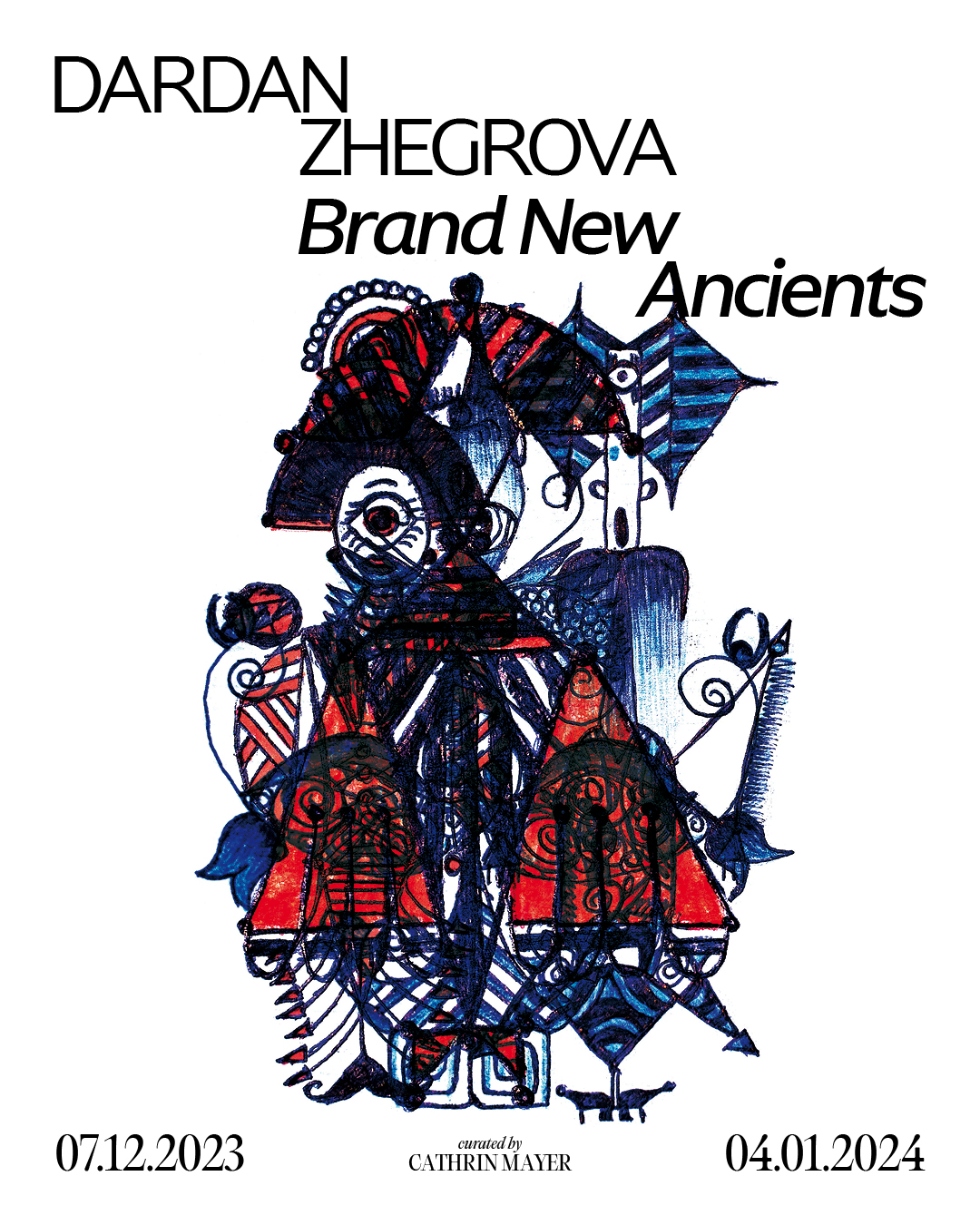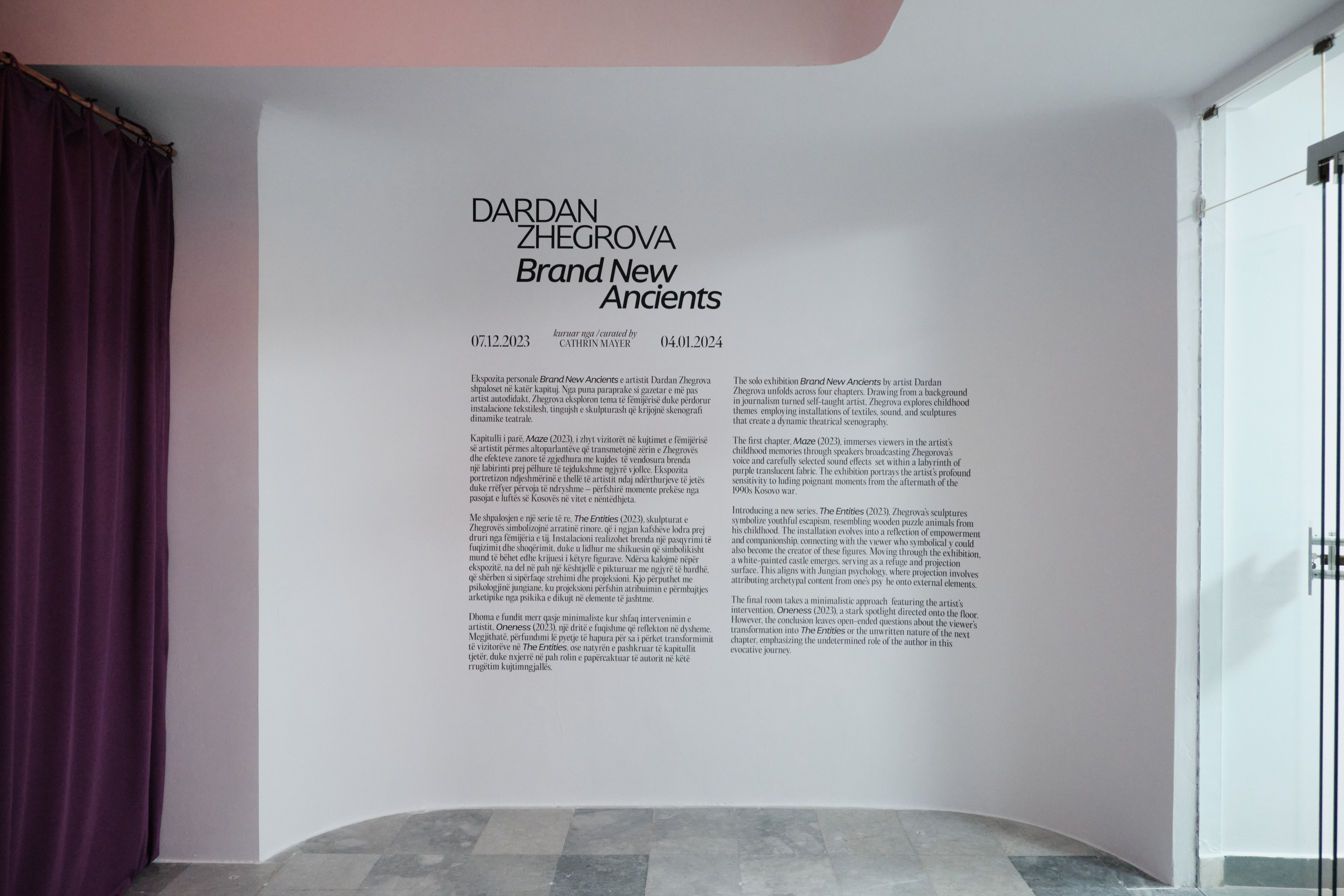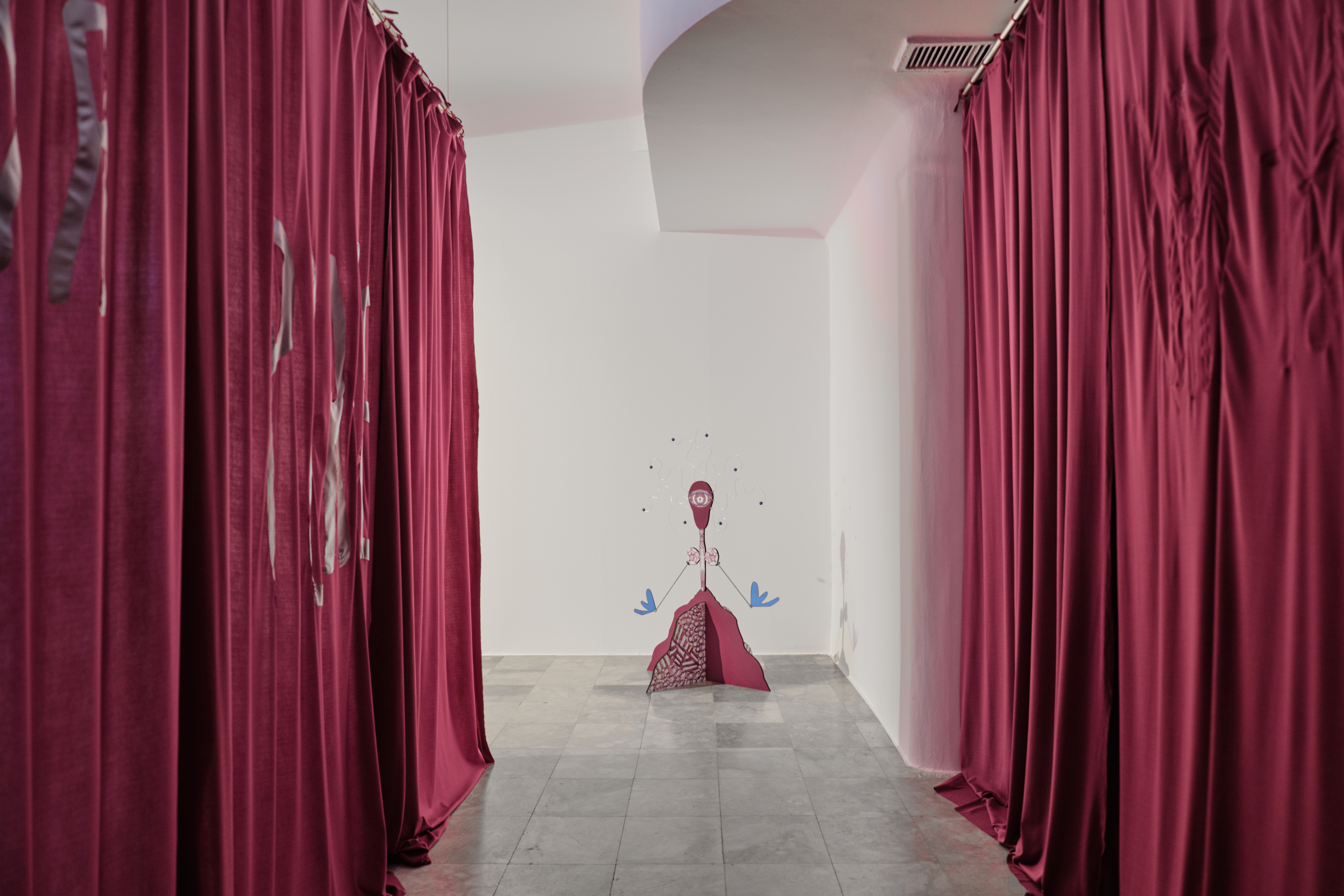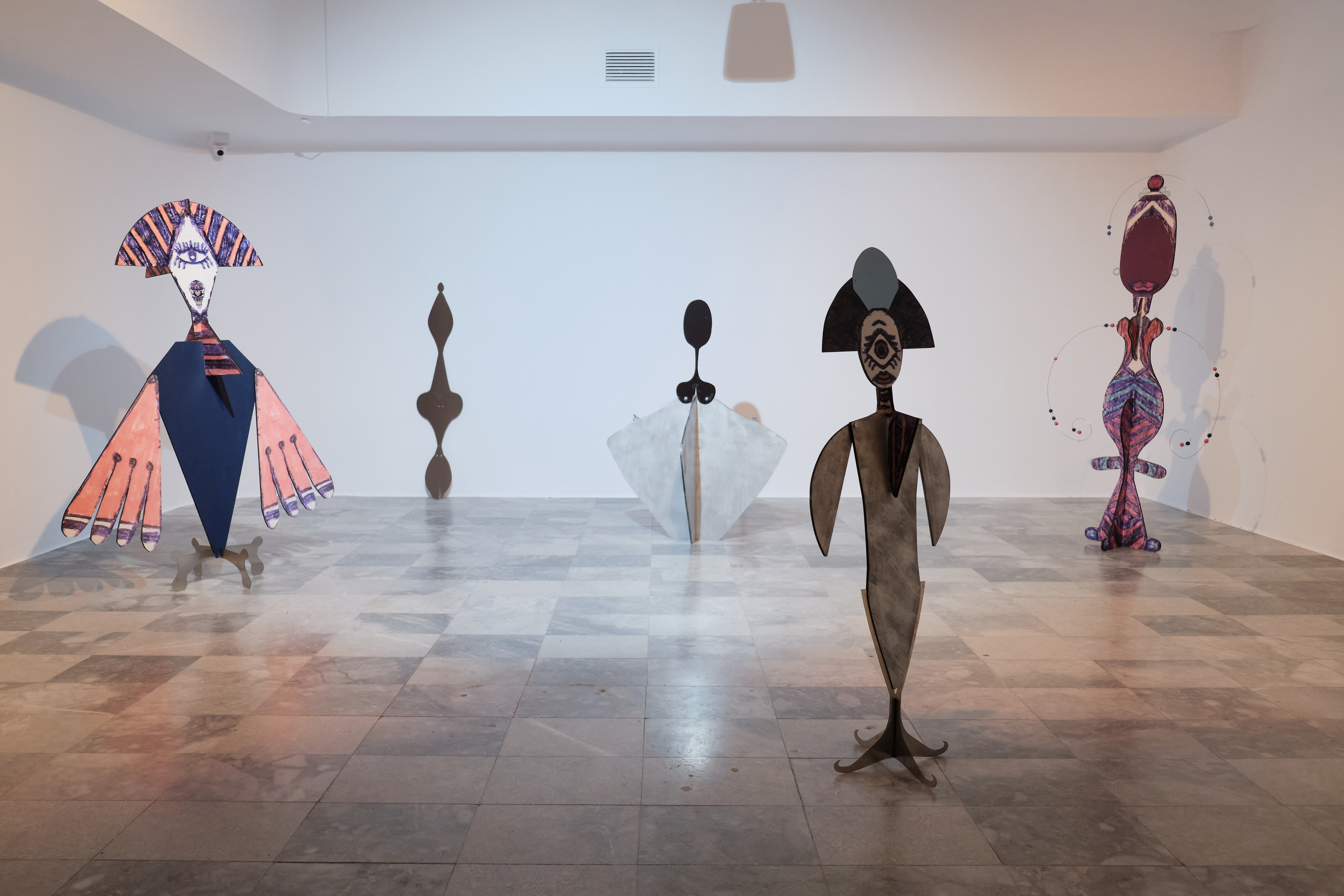Dardan Zhegrova / Brand New Ancients
This exhibition is a continuation of the artist's extensive exploration of childhood themes, expressed through four chapters that occupy the expansive ground floor of the National Gallery featuring exclusively newly conceived works. As suggested by the title, "Brand New Ancients" centers on the idea of creating moments where past lived experiences undergo a transformation into a vibrant present. These lived experiences are vividly portrayed through expansive installations that integrate textiles, sound, and sculptures, all embedded within a comprehensive theatrical scenography.
While Zhegrova's artistic methodology is notably defined by the design of the spaces where he presents his work, his creative foundation consistently originates from writing. This aspect, perhaps the only one reflecting his background as a trained journalist who skilled himself as an autodidact in art, remains integral to his artistic practice. “Maze” (2023) situated in the first room of the gallery is dedicated to the exploration of memories formed by the artist during the approximate ages of four to eight.
Large sections of translucent and opaque fabric in shades of purple are strategically installed in the space to form corridors and compartments. This arrangement challenges the viewer's visual and physical sense of orientation, as they cannot discern what lies beneath the fabric. Exploring the space can be seen as similar to the process and mechanisms of memory, characterized by occasional incoherence or dependence on sensory perceptions of the moment. On certain individual lengths of fabric, Zhegrova has intricately cut out words from a thicker silver fabric. When read together, these words form a sentence: "How to save all this not as a memory but as a place", commenting on the impulse to make ephemeral histories materially tangible, but also accessible to the viewer.
Zhegrova began conceptualizing this room and described it as a process in which “I relived many memories which had to do with animals. The first meeting with God, for example, happened through an ant. I was sitting by the living room window and would crush ants with my fingers and my mum said: “Don’t do that because god will punish you”. This was the first time when I was thinking that what god is to me is what I am for the ants.” This narrative not only stands as a striking representation of memories audible in the "labyrinth" of the initial room but also exemplifies one of five such episodes broadcasted through loudspeakers across the entire exhibition. Each of these distinct memories is enhanced by accompanying sound effects, intensifying the overall impact of the narratives. This particular story demonstrates the artist's remarkable sensitivity in understanding of the broader essence of a world teeming with diverse forms of life and their fragile interconnectedness. During a similar period in his life, another anecdote recounts his exploration of houses left in ruins after the late 1990s war, characterized by a harsh crackdown by Serbian forces against Kosovo-Albanians seeking independence. Amid the fallen walls of one abandoned structure where tall grass had taken root, he and a friend came across a puppy. In a moment of ignorance, they prodded the puppy with sticks, not fully comprehending the consequences of their actions, causing the animal to cry. The psychological transfer or mirroring of emotions, exemplified in both stories by the transmission of pain and helplessness, can be observed on a larger scale in Zhegrova's earlier works. Additionally, it serves as a significant element in this exhibition, a point that will become evident later on.
Leaving the labyrinth of fabric and sound behind, one encounters a series of sculptures that the artist has titled "The Entities" (2023), These sculptures exhibit outlines and specific features that oscillate between totemic figures and anthropomorphic machines. The machine-like impression arises from their materials, such as wood and metal, and their construction, which incorporates various parts, resembling limb-like structures to facilitate movement. Their design is based on simple wooden, three dimensional puzzle animals, which the artist as a child often played with by arranging and connecting multiple pieces that interlock or fit together to form the final structure. Typical to Zhegrova aesthetic the sculptures are embellished with decorative materials and fabric breathing life and individual character into the graphic silhouettes. In the presence of ambient sounds in the room, it becomes uncertain whether the sculptures are actually communicating with the viewers or if it's simply a product of their imagination.
During the artists’ teenage years, he drew these characters, mostly at school. He describes them as “Creatures that would allow me to escape, they came from the past and were keys into another world. They came from a curious and rebellious kind of mind and opened up a world that I continue to revisit. They started to appear when I was not having fun in school or at home. I did not have an easy time with the other kids, so they became companions. I would always write down when they appeared, with the date, time and location, so that I could trace the moment and be sure that it happened.” "The Entities" have transformed into a tangible representation of this youthful melancholic escapism, evolving into a fountain of creativity that Zhegrova continues to employ to this day. They could be perceived as imaginary companions, friends, or guardians, yet at the same time, they serve as a source of empowerment that the artist is offering to both himself and the viewers. Like his previous series “Voodoo Dolls” (2015 - ongoing) and “The Hybrids” (2020 - ongoing) which were all built with interactive elements engaging with the viewers, “The Entities” continue this exploration. “Voodoo Dolls” the first works inspired by doll-like objects introduced the concept of “sympathetic magic” which is a psychological principle that suggests that by imitating an action on a representation of something or someone, one can influence the real thing.
Within the context of Brand New Ancients, the concept of “sympathetic magic” could be equated with the psychological term of “make-believe play” that refers to a type of play in which children engage in imaginative and symbolic activities, often involving the creation of imaginary scenarios, roles, and situations, which replicate or counteract reality. The above mentioned transfer or mirroring of emotions comes here to play again, as “The Entities” as friends, today can be influenced in their construction which symbolically speaking could also mean the influence on their actions. Zhegrova emphasizes here the significance of his sculptures being not only relevant within the framework of his biography but also designed for the public to potentially become creators and users of these artworks.
As you progress into the next room, you come across an unfolded template that takes on the form of a castle or fortress, complete with snug nooks and crannies furnished with plentiful cushions for comfortable seating. Within this journey, the castle serves as a symbol of refuge and security, which Zhegrova strategically placed after “The Maze” and “The Entities” installations representing disorientation and the quest for community. The castle functions not only as a resting place but also transforms its walls into projection surfaces, where you can encounter acrylic drawings inspired by the earlier mentioned memories. The term projection here can not only be used in reference to technique in use, but to its psychological meaning. According to Gustav Jung’s analytical psychology projection is understood as the attribution of archetypal content present in one's own psyche to other people or material objects. Similar to prior occurrences in the show, "The Castle" (2023) aims to initiate a process in the viewer, fostering a connection between the imagery presented and their personal associations.
The concluding room, marking the final chapter of the Brand New Ancients journey, is intentionally maintained in a starkly minimalistic style, creating a striking contrast to the opulence of the preceding rooms. The sole intervention “Oneness” (2023) presented by the artist is a stark spotlight directed onto the floor, casting illumination upon anyone who steps into its beam.
Consistently upheld throughout the exhibition is a direct engagement with the viewer, vividly demonstrated in this particular instance. However, this conclusion raises several unresolved questions. For example, one could hypothesize that the viewer has metamorphosed into one of "The Entities." On the other hand, it might suggest that the next chapter is still unwritten, and the determination of the author is yet to be decided.



